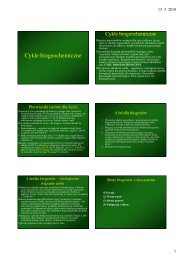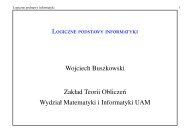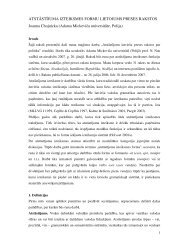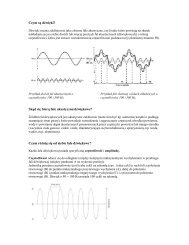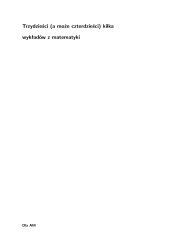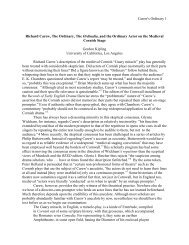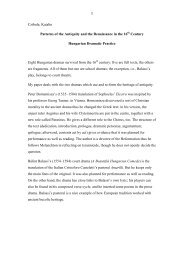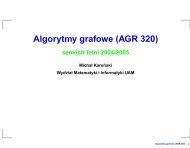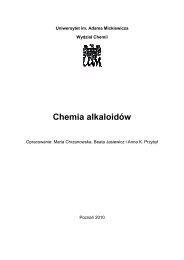Skale muzyczne
Skale muzyczne
Skale muzyczne
You also want an ePaper? Increase the reach of your titles
YUMPU automatically turns print PDFs into web optimized ePapers that Google loves.
<strong>Skale</strong> i systemy strojenia<br />
III rok Reżyserii Dźwięku<br />
Anna Preis<br />
3.04.12<br />
AM_8_2012
Gramatyka muzyki<br />
• Większość muzycznych kultur używa<br />
dyskretnych elementów o określonej<br />
wysokości – zapisanych w postaci nut.<br />
• Zakładając, że muzyka bazuje na<br />
zbiorze nut, istotne są relacje pomiędzy<br />
nimi.<br />
• Najistotniejszą relacją pomiędzy nutami<br />
która porządkuje ich zbiór jest oktawa.
<strong>Skale</strong> <strong>muzyczne</strong><br />
Są to zbiory dyskretnych wartości<br />
wysokości dźwięku.<br />
Są one podstawą komponowania i<br />
improwizowania muzyki w większości<br />
kultur muzycznych.
Liczba nut w oktawie<br />
• Praktycznie 5-7 dźwięków wypełnia<br />
oktawę<br />
– pentatonic (5 notes/octave)<br />
– diatonic (8 notes/octave)<br />
– chromatic (12 notes/octave)<br />
– "microtonal" (from Western<br />
perspective, > 12 notes/octave)
<strong>Skale</strong> <strong>muzyczne</strong><br />
W muzyce indyjskiej istnieją teoretycznie<br />
22 interwały w obrębie oktawy.<br />
W muzyce arabskiej 15-24.
<strong>Skale</strong> siedmio i pięcio<br />
stopniowe<br />
W muzyce Indonezji, Malezji usłyszeć<br />
można skale 5-stopniowe o w przybliżeniu<br />
równomiernej temperacji. W muzyce<br />
Ugandy występuje podobna skala 7-<br />
stopniowa.<br />
Shankar Ravi indonezyjska Indonezyjska-gamelon
Muzyczne nuty<br />
• Każda oktawa tworzy interwał i<br />
konstruowanie skali polega na<br />
wypełnieniu tego interwału pośrednimi<br />
tonami.<br />
• Jak to robić? Dwie tendencje:<br />
– wybierać dźwięki które razem brzmią<br />
łagodnie, konsonansowo<br />
– wybierać dużo dźwięków aby<br />
zapewnić różnorodność
Zasady wyboru nut w<br />
skalach<br />
• Zgodnie z pierwszą zasadą –<br />
konsonansowość brzmienia. Konsonans<br />
wtedy, gdy duża liczba harmonicznych w<br />
dźwięku pokrywa się. Interwały<br />
charakteryzujące się stosunkami małych<br />
liczb spełniają to wymaganie<br />
– Kwinta jako konsonans (Pythagorean tuning)<br />
– Interwały reprezentowane przez stosunki<br />
małych liczb (just tuning)
Wspólne<br />
harmoniczne
Względny konsonans<br />
interwałów<br />
• Miara konsonansu podana przez<br />
Nordmarka i Fahlena 1988 tabela 14.5<br />
• Ta tabela jest zrobiona dla dźwięków<br />
składających się z 6 harmonicznych o<br />
równych amplitudach. Ocena dysonansu<br />
na skali od 1 do 7
Pythagorean<br />
&<br />
Just tuning<br />
systems<br />
240 Hz x3/2=360Hz<br />
360Hz x 3/2=540Hz<br />
540 powyżej oktawy<br />
480 więc 540/2=270<br />
po 12 takich operacjach<br />
dochodzimy do 486<br />
A nie 480?<br />
Druga strategia, małe<br />
stosunki liczbowe
Jak stworzyć skalę?<br />
System pitagorejski<br />
System naturalny<br />
System równomiernie temperowany
• Pythagorean tuning<br />
• A Pythagorean tuning is technically a<br />
type of just intonation, in which the<br />
frequency ratios of the notes are all<br />
derived from the number ratio 3:2, a<br />
ratio of central importance to the<br />
School of Pythagoras in Ancient Greece.<br />
Using this approach for example, the<br />
12 notes of the Western chromatic<br />
scale would be tuned to the following<br />
ratios: 1:1, 256:243, 9:8, 32:27, 81:64,<br />
4:3, 729:512, 3:2, 128:81, 27:16, 16:9,<br />
243:128, 2:1.
• Just intonation<br />
• In Just Intonation the frequencies of the scale<br />
notes are related to one another by simple numeric<br />
ratios, a common example of this being 1:1, 9:8,<br />
5:4, 4:3, 3:2, 5:3, 15:8, 2:1 to define the ratios for<br />
the 7 notes in a C major scale. In theory a variety<br />
of approaches are possible, such as basing the<br />
tuning of pitches on the harmonic series (music),<br />
which are all whole number multiples of a single<br />
tone. In practice however this quickly leads to<br />
potential for confusion depending on context,<br />
especially in the larger system of 12 chromatic<br />
notes used in the West. For instance, a major<br />
second may end up either in the ratio 9:8 or 10:9.
• Meantone temperament<br />
• A system of tuning which averages out pairs of ratios<br />
used for the same interval (such as 9:8 and 10:9),<br />
thus making it possible to tune keyboard<br />
instruments. Next to the twelve-equal temperament,<br />
which some would not regard as a form of<br />
meantone, the best known form of this temperament<br />
is quarter-comma meantone, which tunes major<br />
thirds justly in the ratio of 5:4 and divides them into<br />
two whole tones of equal size. To do this, eleven<br />
perfect fifths in each octave are flattened by a<br />
quarter of a syntonic comma, with the remaining<br />
fifth being left very sharp (such an unacceptably outof-tune<br />
fifth is known as a wolf interval).
System równomiernie<br />
temperowany<br />
• System równomiernie temperowany to<br />
przyjęty w muzyce europejskiej podział<br />
oktawy na dwanaście odcinków<br />
równych w mierze oktawowej. Jeden<br />
taki odcinek, równy 1/12 oktawy,<br />
nazywamy półtonem. Stosunek<br />
częstotliwości dwóch kolejnych<br />
dźwięków w systemie równomiernie<br />
temperowanym wynosi
• Ukoronowaniem wprowadzenia systemu<br />
równomiernie temperowanego było<br />
opublikowanie przez Jana Sebastiana<br />
Bacha ,,Das Wohltemperierte Klavier'' czyli<br />
zbioru 48 preludiów i fug, we wszystkich<br />
tonacjach durowych i molowych. Potrzeba<br />
systemu temperowanego wypłynęła z<br />
praktyki <strong>muzyczne</strong>j. Bez systemu<br />
równomiernie temperowanego nie dało się<br />
tak nastroić klawesynu (ani żadnego<br />
innego instrumentu) tak, żeby można było<br />
grać czysto w dowolnej tonacji.
• System równomiernie temperowany<br />
został stworzony przez J. Neidhardta<br />
(1706 i 1724) w oparciu o prace<br />
Werckmeistra<br />
• Instrument albo był nastrojony do C-dur<br />
albo do As -dur. Jeżeli było trzeba<br />
zagrać na koncercie jeden utwór w C-<br />
dur i drugi w As -dur, to<br />
przygotowywano dwa, odpowiednio<br />
nastrojone klawesyny. Po<br />
wprowadzeniu systemu temperowanego<br />
wystarczył jeden klawesyn.
Cent<br />
1200 cents are equal to one octave — a frequency ratio of 2:1 — and an equally tempered<br />
semitone (the interval between two adjacent piano keys is equal to 100 cents. This means that<br />
the ratio of one cent is precisely equal to 2 1/1200 , the 1200th root of 2, which is approximately<br />
1.0005777895.<br />
If you know the frequencies a and b of two notes, the number of cents measuring the interval<br />
between them may be calculated by the following formula (similar to the definition of decibel<br />
both formally as well as in its purpose to linearize a physical unit which is exponential but<br />
perceived logarithmically by humans):<br />
Likewise, if you know a note b and the number n of cents in the interval, then the other note a<br />
may be calculated by:<br />
http://www.sengpielaudio.com/calculator-centsratio.htm
Diatonic scale<br />
In Music theory, the diatonic major scale is a fundamental building block of the<br />
Western musical tradition. The diatonic scale is composed of two tetrachords<br />
separated by intervals of a whole tone. The pattern of intervals in semitones is<br />
as follows 2-2-1-2-2-2-1. The major scale begins on the first note and proceeds<br />
by steps to the first octave. In solfege, the syllables for each scale degree are<br />
"Do-Re-Mi-Fa-Sol-La-Ti-Do". The natural minor scale can be thought of in two<br />
ways, the first is as the relative minor of the major scale, beginning on the sixth<br />
degree of the scale and proceeding step by step through the same tetra chords<br />
to the first octave of the sixth degree. In solfege "La-Ti-Do-Re-Mi-Fa-Sol."<br />
Alternately, the natural minor can be seen as a composite of two different tetra<br />
chords of the pattern 2-1-2-2-1-2-2. In solfege "Do-Re-Mi-Fa-Sol-La-Ti-Do." All<br />
of non-folk Western harmony from the some point in the late Renaissance up to<br />
the late nineteenth century is based upon these two objects and the unique<br />
relationships created by this system of organizing 7 notes. It should be kept in<br />
mind that most pieces of music change key, and thus scale, but are still related<br />
to the beginning diatonic scale. The white keys on a piano correspond to the<br />
diatonic scale of C major (C-D-E-F-G-A-B-C), with the notes a whole tone apart,<br />
except for E-F and B-C, which is an interval of a semitone (half a tone). Diatonic<br />
comes from the greek "diatonikos" or "to stretch out". It is sometimes used to<br />
refer to all the modes, but is generally used only in reference to the major and<br />
minor scales.
Modes




